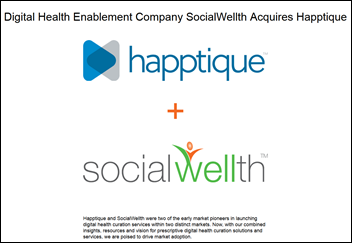Merry Christmas and a Happy New Year to the HIStalk crowd. I wish you the joys of the season!
News 12/12/14
Top News
Experian’s 2015 “Data Breach Industry Forecast” says increased EHR adoption, lax security, and the popularity of wearables will make healthcare an attractive target, although as in all industries the biggest security threat involves an organization’s own employees. The report also says that cloud-based user credentials are increasingly attractive to hackers, with a Twitter login being worth more on the black market than a credit card number.
Reader Comments
From Bimbo Ears at DOH Pa: “Re: Pennsylvania physician licenses. The Licensing Bureau deployed defective software that lost renewal documents for doctors, affecting hundreds if not thousands of doctors whose licenses expire 12/31/2014. The vendor is System Automation, which claims on its website to make government more efficient.” Unverified. I didn’t see anything mentioned.

From Joey Cheesesteak: “Re: Dr. Michael Rosenberg of Health Decisions. Dies in a Maryland jet crash.” Michael Rosenberg, MD, MPH, CEO and founder of the Durham, NC-based contract research organization for drug and device companies Health Decisions, died when the business jet he was piloting crashed into a house in Gaithersburg, MD, killing all three occupants of the plane and a mother and two young sons who lived in the house.
From Ink-Stained Wretch: “Re: Epic’s Judy Faulkner. She never does interviews, but came out of her cloister to speak with VentureBeat and attempt to debunk a critical New York Times story. Perhaps Epic is feeling pressure from the Hill, where Epic is widely blamed for the perceived failure of EHR stimulus and is associated with the unpopular Obama.” Keeping a low profile (or declining all media contact) is great until there’s a PR problem. It appears that Epic is worried about being perceived as an uncooperative vendor of closed systems, especially with the Department of Defense’s EHR bid on the line. I’m guessing the VentureBeat “interview” with Judy was actually a quick email response since only a few sentences were quoted. VentureBeat isn’t the ideal platform for convincing either the industry or the federal government that a New York Times article was unfair or inaccurate, but odd publications seem to get through to Judy every now and then to get a couple of sound bites in the form of a quick denial of statements made in other publications.
From Dr. Herzenstube: “Re: new federal health IT strategic plan. It’s actually a pretty quick read at only 28 pages and a bit less platitudinous than one might expect. One item of particular note is the prominent acknowledgement by ONC that the potential safety hazards of HIT need to be better understood and addressed. Among the high-level objectives for the five-year period is, ‘Increase user and market confidence in the safety and safe use of health IT products, systems, and services.’ The document notes, ‘Evidence suggests health IT improves patient safety; however, health IT products can also lead to medication errors and other adverse outcomes. Additionally, poor implementation or improper use of otherwise safe systems can also lead to adverse outcomes. Clinical and other health providers and individuals must be able to rely on health IT systems to perform safely.” The optimist in me appreciates ONC’s recognition that the federal government’s healthcare IT bailout program has had both positive and negative effects on patients. The cynic in me wonders if this isn’t a pitch for ONC to save itself from irrelevance by elbowing its way into the health IT safety business via its self-proposed Health IT Safety Center, which Congress seems unwilling to support financially or otherwise.
From ICD Lay No More: “Re: ICD-10. Someone started a petition on the White House website to “Implement ICD-10-CM/PCS on October 1, 2015 – no further delays.” The signature count so far is 239.
HIStalk Announcements and Requests
This week on HIStalk Connect: Happtique, a digital health startup that spent several years working to bring legitimacy to the mHealth market through its app certification program, is acquired by SocialWellth for an undisclosed sum. Doximity, the LinkedIn for doctors, hits 400,000 users, meaning that it has now penetrated more than 50 percent of the US physician population. Walgreens announces that it will partner with MDLive to begin offering telehealth visits through its digital health app.
This week on HIStalk Practice: Health First selects PatientKeeper software. Allscripts inks an ePA deal with Express Scripts. Tandigm Health goes with Lumeris population health tech services. Johnson County Mental Health Center connects to the Kansas HIE. Wearables finally make it to the ear. Survey results highlight HIPAA’s education problem. Thanks for reading.
Webinars
December 17 (Wednesday) 1:00 ET. There Is A 90% Probability That Your Son Is Pregnant: Predicting the Future of Predictive Analytics in Healthcare. Sponsored by Health Catalyst. Presenter: Dale Sanders, SVP of strategy, Health Catalyst. Predictive analytics is more than simple risk stratification. Once you identify an individual’s risk, what are the odds that you can change their behavior and what will it cost to do so? This presentation, geared towards managers and executives, addresses scenarios in which predictive models may or not be effective given that 80 percent of outcomes are driven by socioeconomic factors rather than healthcare delivery.

McKesson launches a strategic venture capital investment fund that will take minority positions in early- and growth-stage companies, with rumored investment totals in the hundreds of millions of dollars range.
Diagnostic device vendor Welch Allyn acquires the assets of Omaha, NE-based remote vital signs monitoring technology vendor HealthInterlink, saying it will offer US customers the FDA-cleared mHealth solution.

Streamline Health reports Q3 results: revenue up 2 percent, EPS –$0.14 vs. –$0.50, missing analyst expectations for both. Above is the one-year share price chart of STRM (blue, down 40 percent) vs. the Nasdaq (red, up 19 percent).
Madison, WI-based health IT incubator 100health, announced less than a year ago, shuts down, with the former Epic employees who founded it refocusing their energy on one of its startups Redox, which is working on APIs to access EHR information. One of those founders, Niko Skievaski, says the incubator’s model of taking 5 percent equity in very early startups didn’t provide cash flow, questions arose about how investors would be repaid when companies exited, and the founders of the participating startups relied too much on the partners as day-to-day managers.
SocialWellth acquires what’s left of Happtique from Greater New York Hospital Association. The highly hyped application certification service Happtique outlived its questionable usefulness a year ago when some of the apps it had approved were found to have ridiculously obvious security flaws (like storing PHI as plain text). SocialWellth offers “balanced living apps” that it describes as murkily and buzzword-heavily as possible in the hopes of sounding like it offers whatever a prospect might want to buy:
DIGITAL HEALTH ENABLEMENT TOOL KIT. Delivering Connected Consumers with Contextualized Experiences. As a leader in consumer and prescriptive digital health, SocialWellth enables payers, providers, and employers by delivering a wide spectrum of white label experiences and facilitating a connected experience between members and their payers. SocialWellth enables the curation of digital health experiences by leveraging mobile health technologies that allow for integration and aggregation of all digital assets, which improve the overall consumer experience.
Sales
Hartford HealthCare (CT) chooses RightCare’s assessment, referral, and care coordination software to reduce readmissions.
Cook Children’s Health Care System (TX) chooses Strata Decision for budgeting, capital planning, long-range financial planning, rolling forecasting, and reporting.

Health First (FL) selects PatientKeeper charge capture, expecting to go live with 90 hospitalists in January with integration to its GE Healthcare systems.

University of Vermont Medical Center (VT) will replace pagers with Imprivata Cortext secure communications.
Banner Health (AZ) chooses Craneware’s Chargemaster Corporate Toolkit.
Physician management services vendor Women’s Health USA chooses athenahealth’s EHR, revenue cycle, and patient engagement services for its 250 providers. The companies will also jointly offer their bundled services to other physicians.
People

Jamie Coffin, PhD (Clarify Healthcare) is named CEO of ambulatory surgery software vendor SourceMedical.

Eric Poon, MD, MPH (Boston Medical Center) is named chief health information officer of Duke Medicine (NC).

MedAssets promotes Mike Nolte to president and COO.

ADP AdvancedMD hires Arman Samani (Medhost) as CTO.

MedSys Group appoints President Steven Heck as board chair, replacing Luther Nussbaum, who will remain on the board.

Leidos Health names Steven Russell (Quantros) as SVP of sales and strategic accounts.

Philip Loftus (Aurora Health Care) joins SSM Health (MO) as CIO.
Announcements and Implementations

Allscripts announces its eAuth electronic prescription prior authorization module for Express Scripts patients.
![]()
Summit Healthcare offers the Express Connect web services adapter, allowing its interoperability platform customers to connect to applications using universal standards such as HTTP, XML, SMIME, SOAP, and JSON.

Health Catalyst announces its collaboration with Microsoft centered around the latter’s Analytics Platform Services.
Microsoft profiles the use of its technologies for the volunteer cleft palate surgery missions of Operation Smile, including Windows 8-powered Asus tablets running a digital patient assessment system, Slainte Healthcare EMR, Office 365, and OneDrive for Business.
Time names “The Ebola Fighters” as its Person of the Year.
Government and Politics
Federal judges shut down a billion-dollar VA hospital construction project in the Denver area after finding that the poorly planned and managed project is so over budget ($400 million or more) that the agency can’t pay for. It’s the fourth huge VA construction project that failed to hit budget and schedule targets. The VA’s contractor says it is owed $100 million and suggests letting the US Army Corps of Engineers replace the VA in managing the hospital’s completion.
The New Orleans newspaper features the recent HIMSS EMRAM Stage 7 accomplishment of Ochsner Medical Center – North Shore (LA), an Epic user.
A Madison news site profiles Epic’s 122-member culinary team, whose head chef says he’s “never worked with a more talented group of cooks,” of which only five have left since he arrived in 2009. He’s planning the opening of a new 51,000 square foot dining hall in May that will require 42 new team members to operate. The chef says kitchen working conditions are family friendly and nearly all menu items are made from scratch. This is the most interesting factoid to me: 80 percent of employees eat on campus at subsidized prices, saving the company $450,000 per day in otherwise lost productivity. That’s not so great for area restaurants, but brilliant in terms of keeping salaried employees at their desks longer.
Up to 40 hospitals in Queensland, Australia go to downtime procedures when a data center storage controller software upgrade fails. Some systems were set up to fail over, but those that weren’t include an endoscopy system that’s used by 33 hospitals.
Minnesota state investigators blame a resident’s death on a “cheat sheet” that incorrectly indicated DNR (do not resuscitate) and missing code status in the EMR. An aide notified nurses when she found the man gasping, but the licensed practice nurses who responded did not attempt to revive him because of confusion about his DNR status.
I like Practice Fusion’s eight tips for maximizing patient engagement while using a computer in the exam room.
Weird News Andy titles this article “Disappearing Docs.” Federal investigators find that half of the Medicaid providers listed in its directory either don’t exist or aren’t taking new patients.
A federal judge sanctions Aetna and its subsidiaries ActiveHealth Management and Medicity for the company’s response to a patent infringement lawsuit brought by HealthTrio. Aetna’s attorneys designated 90 percent of the 862,000 pages of information it submitted as viewable only by its own outside attorneys, which the judge declared to be “absurd.”
Guam Memorial Hospital says it received inadequate training for its October conversion to NTT Data’s financial system, causing the CFO to have an uncertain picture of the hospital’s financial situation. It’s asking the company to send people back on site for a month.
Orlando ophthalmologist Jack Parker, MD sues his office’s former medical software specialist (and former fiancee, who moved out of his mansion in September), demanding that she return her $60,000 engagement ring, $70,000 Porsche, and a dog he spent $3,500 to train. She responded, “It’s my stuff.”
Jordain Shlain, MD pens (or keyboards) a completely brilliant poem that sums up the practice of medicine over many centuries that could be turned into perfect music as in REM’s “It’s The End of the World as We Know It (And I Feel Fine)”. An excerpt:
Arrays of genomes enable our cancer fight
microbiomes, proteomes, IBM Watson enable high-def insight
to support people suffering, needing a human light.
to comfort and treat; a data-enabled line of sight.Medicine is, has always been and will always be
a people business, predicated on humanity
In need of data and human support.
Not, as most data-gold diggers purport:
Medicine is a data business in need of people.
Sponsor Updates

- Medicomp is integrating Quippe and the MEDCIN Engine with the Soteria clinical management system of Infocare in South Africa. Above are Medicomp team members Jay Anders, MD (chief medical officer), Dan Gainer (CTO), Jason Valore (senior manager of solutions), and Dave Lareau (CEO) at the Cape of Good Hope.
- Forward Health Group is designated as a “High Performing” vendor in a new KLAS report on population health performance, with a 100 percent “Would Buy Again” score and a top ranking in categories such as “Money’s Worth,” “Keeps Promises,” and “Ranked Client’s Best Vendor.”
- SyTrue and nVoq will jointly market their respective smart data platform and speech recognition systems.
- EDCO Health Information Solutions publishes a case study of the use by City of Hope National Medical Center (CA) of the company’s Solarity medical records scanning and indexing system, which is 50 percent faster than paper processing and adds HIM quality and productivity tracking.
- Impact Advisors publishes an article titled “Population Health Management – Development a Roadmap.”
- The HCI Group lists its “Top 10 Most Popular EHR Articles of 2014.”
- The CoCENTRIX Coordinated Care Platform receives ONC-ACB EHR Complete 2014 Edition Certification.
EPtalk by Dr. Jayne
My inbox has been humming since this week’s Curbside Consult appeared. In addition to getting quite a few comments about the original Forbes piece, readers have had a lot to say about the overall idea of fashion advice for conference attendees and presenters.

From Handbags Ta Di For: “Perhaps the mHealth ladies can purchase this ‘fussy’ purse. Space Cadet ?!?” Although it’s from Kate Spade, who is one of my favorites, it’s probably not going to make my holiday wish list.

From Roy G. Biv: “Is it my imagination or are two of those accessories a stethoscope and doctor’s bag?” Not exactly. I think it’s a fussy necklace and a pretty big satchel. I’m pretty sure neither an otoscope nor an ophthalmoscope has ever seen the inside of that one.
From Mountain High: “There is a lot to be said on this topic beyond the presentation at a conference. Do people care about the dress of their provider? Do people look at their doctors and expect a certain amount of dress? Our hospital has banned ties for clinicians, which has resulted in a hodgepodge of male dress, and has almost completely eliminated dresses/skirts for clinical women as well, which has resulted in an army of khaki pants. Since nurses are still clad in scrubs, what is the expectation of your provider, should they wear their white coat? Many of ours are not donning the lab coats as they just don’t like them (and they come in three horrendous sizes unless you wish to buy, wash, and maintain your own). Currently my otherwise well-dressed partner is wearing a white muu-muu, as the sizes of lab coats run from men’s large to Andre the Giant XXXXXL.” A close friend of mine works at a prominent integrated health system that shall remain nameless. Several years ago they lived through “hosiery-gate,” which started with complaints about male physicians wearing loafers without socks. It ended up requiring “hosiery for all personnel.” She protested the idea that the hospital should dictate wardrobe to that degree by wearing various combinations of crazy socks with dresses so everyone could see them. Her patients know she’s a free spirit and got a kick out of it but the administration was not amused.

From Mixed Marriage: “Can we please address the Dansko clog? There are now over 250 variations of them, from the basic black or brown, to the most artistic floral patterns. Does your hospital provide any shoe-cleaning service? Because it should. As an IT person, even though I limit my clinical area time to as little as possible, I still religiously clean and polish my shoes not to make them look good, but to eliminate bringing germs and hospital funk into my car and house. How many other people think that through?” If I’m going to wear clogs, my personal favorite is Medimex Plogs. They’re bleachable and you can even autoclave them, although I doubt my hospital would let me just throw them in. You do have to watch out, though, because some of them are vented on the sides, so if you’re going to be anywhere gooey, you need to wear shoe covers. They also have massaging nubbins on the inside which is great during a long shift in the ER.
From Selfish: “Dr. Jayne, I think you have it all wrong. Everyone knows the real reason that people – especially women – go to conferences is to network and be seen. It’s not about learning or selling or presenting. I mean, really, do people actually listen to all 55 minutes of a conference presentation? Of course not. While we are pretending to listen, we are really asking ourselves if the presenter’s hairstyle would look good on us or if we could pull off that color scarf. Everyone knows that what really matters is whether one’s eye shadow is coordinated with their belt. After all, we live in the world of Instagram, Facebook, and Match.com, where image is everything and where we spend hours a day just looking at pretty pictures. Don’t be fooled people: all those mHealth folks aren’t staring at their iPhones looking at medical apps – they’re checking Instagram to see how many likes they got for their latest selfie.”
I’m giving this reader the inaugural Jonathan Swift “Modest Proposal” award for using satire to make us think. For many attendees, networking is the only reason to go to a conference. Whether you’re looking for your next opportunity or wanting to solidify or renew business relationships, looking successful is a key part of the event. For those that are addicted to social media, it is taken to a whole new level. Of course HIMSS is the granddaddy of “see and be seen” events and I’m certainly no stranger to critiquing fashion, shoes, or booth attire at the show.
I’m still receiving feedback as I write this and have even received a special guest post photo essay straight from the halls of the mHealth Summit. Stay tuned for Monday’s Curbside Consult. You won’t want to miss it.
Contacts
Mr. H, Lorre, Jennifer, Dr. Jayne, Dr. Gregg, Lt. Dan, Dr. Travis.
More news: HIStalk Practice, HIStalk Connect.
Get HIStalk updates.
Contact us online.













Was forced to attend a summer of boring, overly hyped, sophomoric classes at Epic one summer. Only food I saw was donuts for breakfast and equally bad food for lunch. No thanks.
Re:. The cynic in me wonders if this isn’t a pitch for ONC to save itself from irrelevance by elbowing its way into the health IT safety business via its self-proposed Health IT Safety Center…
Amen…long live cynics!
…or perhaps ONC has – at long last – come to the conclusion that something needs to be done to better understand and prevent unintended consequences of health IT.
The really cynical among us would wonder why the FDA already hasn’t done this.
Ron